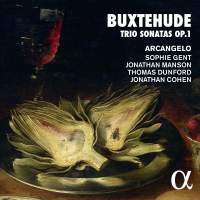Texte paru dans: / Appeared in: |
|
|
Outil de traduction ~ (Très approximatif) |
|
|
Reviewer: Barry
Brenesal No sooner did I receive one album for review featuring Arcangelo recently (works of John Blow; Hyperion 68149), then a second appeared. While that release included 10 instrumentalists and eight singers, this one sees the ensemble slimmed down to four performers: violinist Sophie Gent, gambist Jonathan Manson, lutenist Thomas Dunford, and Jonathan Cohen, direction and harpsichord. They follow the practice found in some recordings of these works, splitting the continuo in two, which allows for greater textural diversity. Since the division is between lute and harpsichord, it’s also a more transparent sound than that achieved by the otherwise attractive Boston Museum Trio’s use of organ continuo (Centaur 2391). It’s perhaps not surprising that, given the quality of his soloists, Cohen has chosen to use relatively relaxed (but by no means under-energized) tempos in faster movements to support greater dynamics, more ornamentation, and interplay between the musicians. The alternating banter and cantabile singing that’s gained from such an approach recalls a performance of the Fourth Sonata I saw live a few years back featuring Julie Andrijeski. There was a sense then that, within the proper musical context, almost anything could happen; and that’s very much the case here as well. This contrasts with Manfred Kraemer’s well-played quartet version (Harmonia Mundi 1951746), where the tempos are faster in fast movements, with an sense of exhilaration gained at the expense of nuance. This isn’t to say that the galloping, single-note repeat sections of the Sixth Sonata lack here for speed, excitement, or precision. It’s just that when speed isn’t the only factor to consider, Arcangelo creates greater musical excitement rather than a strictly visceral thrill. It helps, too, that the engineering gives the continuo an audible and important part in the proceedings, instead of relegating it to a distant plane of existence. More colorful than the Purcell Quartet (Chandos 0766), less manic and driven than L’Estravagante (Arts Music 47731), more adventurous than the staid version featuring Holloway, Linden, and Mortensen (Naxos 8557248), this is definitely a keeper. | |
|
Support us financially by purchasing this disc from eiher one of these suppliers. Un achat via l'un ou l'autre des fournisseurs proposés contribue à défrayer les coûts d'exploitation de ce site. |
|
|
|
|
|
Cliquez l'un ou l'autre
bouton pour découvrir bien d'autres critiques de CD |
|




